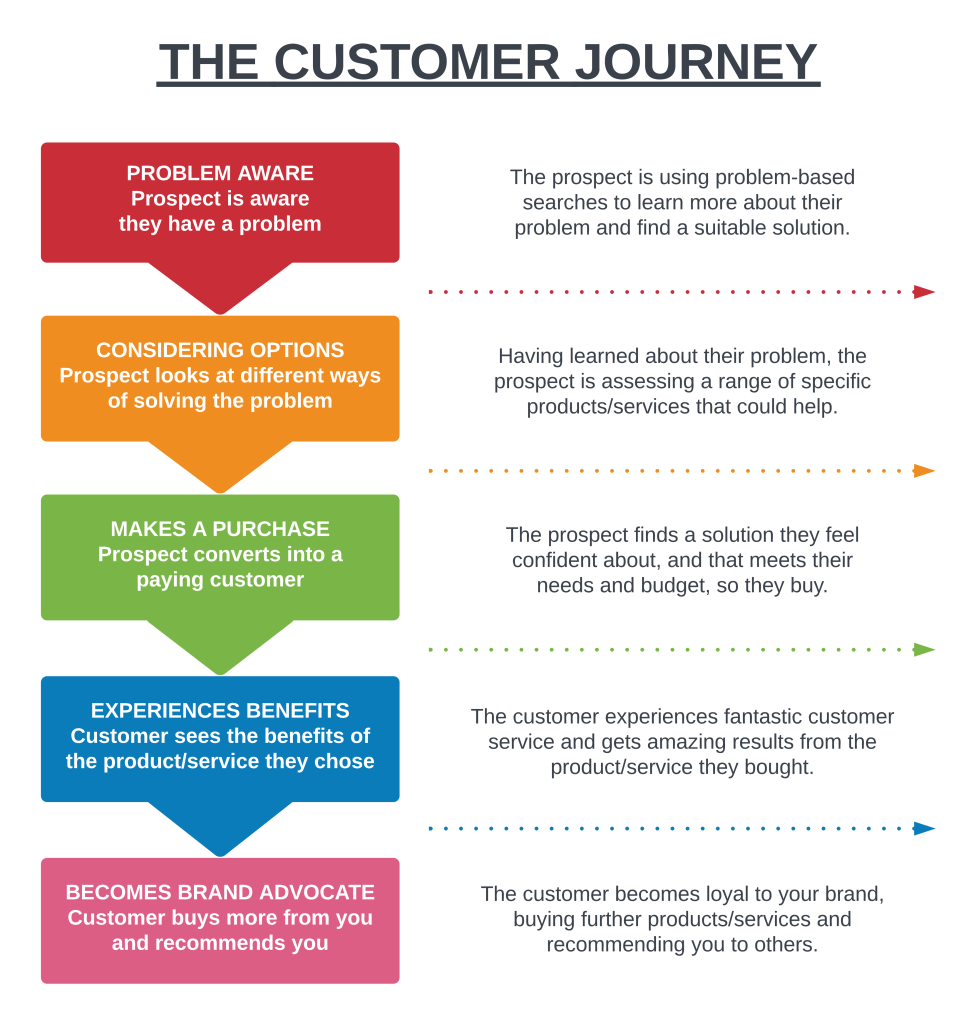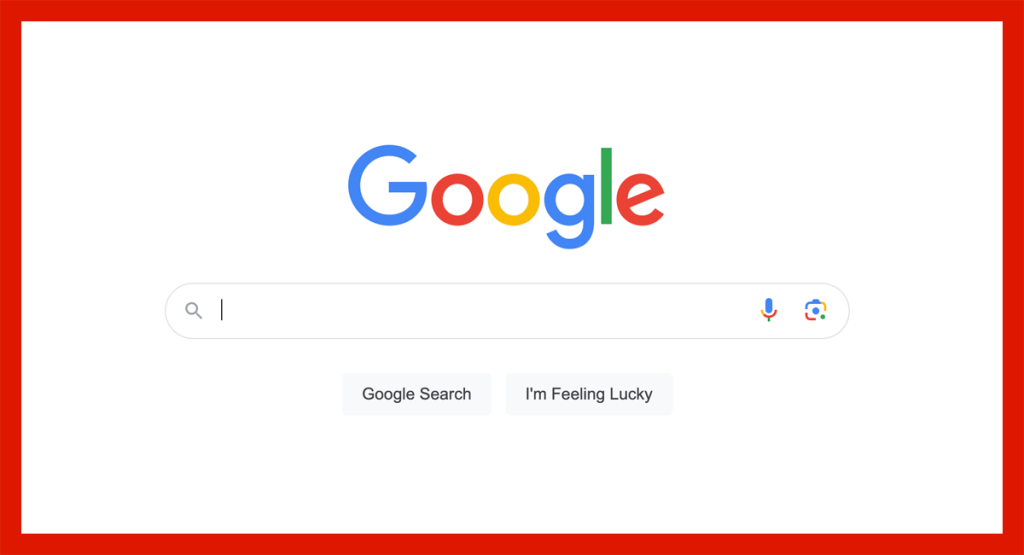UPDATED JULY 10, 2024
Your blog content should be converting
The main role of blog content is not to sell, but to help your prospects buy.
It does this by giving them the information, inspiration and advice they need to be able to make a purchase.
So it’s perfectly possible for your blog content to convert visitors into sales and subscribers. And if yours isn’t, you might need to look at your strategy.
Before we dive in to where you might be going wrong, you need to understand the customer journey and how it works.
The customer journey
Here’s an ideal overview of the customer journey from the time the prospect becomes aware they have a problem to the time they make a purchase and then eventually become an advocate for your brand.
Ideally you should have a strategy in place that covers content for your prospect/customer at each of these stages of their journey.


Now you can see the basic customer journey your prospects are taking, let’s move on to the reasons your blog might not be working for you. And, more importantly, how to fix those issues.
11 Reasons why your blog content isn’t converting
1. You’re working without a strategy
For your blog to convert, you need to have a strategy in place.


What your content strategy should cover
Your strategy should cover things like your:
- Aims and objectives
- Themes and topics
- Target audiences
- Internal linking
- SEO keywords.
An effective strategy will guide your content, giving it the purpose, direction and value you need to achieve your goals.
2. You’re using your blog for company news
Company news has a specific audience, which is typically investors, partners, affiliates, employees, recruiters, job applicants and others with an interest in how the company operates.
These are not the people who will buy from you.
If you’re a small company, you might question if you have an audience for company news. Because if nobody’s reading it, you’re wasting time writing it.
If you’re a larger company and you have a large enough audience for your company news, put it on a separate company news page and keep your blog free for articles that will help your prospects.
3. You’re using your blog as a sales tool
As I said at the beginning, the main role of a blog is not to sell, but to help your prospects buy. And there’s a big difference.
If your content is salesy, your visitors can find it really off-putting. Especially if what they really need is impartial information that will help them make the right decision.
Why should your content be impartial?
Giving visitors the right information helps them find the best solution to their problem. Something that works well for them and fulfils their needs at the price they want to pay.
That might not always be your solution — but that’s okay. Because if your solution isn’t right for them, they’re probably not your ideal customer — at least, not for the time being.
Being impartial and giving the best advice is an excellent way to build trust. So even if you don’t convert this person this time, you will have given them positive experience they’ll remember. And, as a result of that, they’ll be more likely to recommend you to others, or come back to you in time.
4. You’re not “listening” to your audience


Your content should be about helping your audience to buy. But how do you know what help your audience needs?
If your content is based on your assumptions about what your audience needs, it might not be hitting the spot. But you can change that by “listening” and learning.
How to “listen” to your prospects
By “listening”, I mean listening to the prospects who contact you, but also researching what your ideal customers are asking, talking about and looking up online.
For example, you might look at:
- What problems they’re having
- What questions they’re asking you
- What questions they’re asking Google
- What information they’re searching for.
By actively “listening” to what your audience wants, you can create better content for them so they’re more likely to convert into customers.
5. Your content isn’t targeted
If your content isn’t targeted, with a specific audience and message, it won’t reach the right people, it won’t speak to the right people — and it definitely won’t convert the right people.
How to target your content
For every piece of content you create you should ask and answer the following questions:
- Who do you want to reach?
- Where are they in your customer journey?
- How are you going to reach them?
- How are you going to help them?
- What conversion do you want to achieve?
Here are some example answers to those questions:
- People who need IT support
- Problem aware — they know they have a problem
- SEO keywords that describe the problem they’re having
- A how-to that will help them fix their problem
- Get them to sign up to your mailing list.
Targeting your content for conversions
To get the maximum number of conversions from your content, you should be targeting people at all stages of your customer journey. This includes everyone — from those who’ve just realised they have a problem, to the brand advocates who already love you and buy from you consistently.
With a proper plan in place, you should start getting the conversions you want.
6. Your content waffles too much
If your reader is looking for answers, it’s likely they’ll want those answers quickly.
So if you’re leading with long and waffly introductions or your content takes ages to get to the point, they might leave before you’ve given them what they needed. And they definitely won’t be converting.


What should you do instead?
Keep your intro brief and get straight to the good stuff you promised in your headline.
Expect that your readers will skim your content and use a format that makes it easy for them. Use short paragraphs that are easy to digest and relevant headings to introduce each section.
7. Your content is poor quality
Your audience isn’t going to read any old rubbish. And if your content isn’t up to standard, they’re never going to convert either.
What makes content poor quality?
Here are some examples:
- Lots of spelling mistakes and grammatical errors
- Paragraphs that finish mid-sentence and don’t go anywhere
- Not giving enough depth or detail
- Making bold claims without giving any evidence
- Citing ‘John Smith’s Blog’ as your source of information
- Using Ai and not bothering to edit or fact-check it
- Not delivering what your headline promises.
How to write content that converts
If you want those conversions, your content should be:
- Well-written and interesting to read
- Packed with value and usefulness
- Well-researched with original sources credited
- Formatted well and easy to skim-read
- Optimised for Google, but not written for Google.
8. You’re writing your content for Google
If you’re writing your content for Google rather than the people you want to sell to, no wonder it’s not converting.


Heads-up: Google is not your ideal customer and is never going to buy from you.
You can have the best-optimised and highest-ranking piece of content, but if it doesn’t give your human audience what they need, it’s never going to convert.
This is why you should always write for your human audience first and optimise for Google.
Google is a lot smarter than it used to be. And it knows when content is good or bad quality. If you’re focusing on writing good quality content and optimising it for Google, you should be getting it right.
9. Your prospects aren’t seeing your content
By this point, you should understand the importance of creating high-quality, audience-first content. But that content isn’t going to do anything for your business if nobody is looking at it.
So when you’ve created your content, you need to get your ideal customers’ eyes on it.
How to get your content in front of your prospects
- Optimise the content so they can find it on Google
- Promote the content on your social media platforms
- Repurpose the content for different platforms
- Include links to the content in your marketing emails.
10. You’re not including a CTA in every post
You know that saying: if you don’t ask, you don’t get?
That applies to your blog content.
Because if you’re not prompting your reader to take some form of action after reading your article, chances are, they’ll leave your site without doing anything.
A call to action, or CTA, is a prompt for your reader to do something. There should be at least one CTA on every blog post you publish and it should give your reader somewhere else to go.
That might be pointing them in the direction of:
- The sign-up page for your email list
- Other articles they might find helpful
- A sales page on your website.
The action you want your readers to take, in each case, will depend on the content of your article. But the idea is to keep moving your reader through your customer journey, so they’re always one step closer to converting.
11. Your CTAs aren’t compelling enough
The CTAs you use in your article need to be irresistible enough to inspire your reader to act. If they’re not, that could be impacting your conversions.
Sow how do you make your CTA more compelling?
Turn your CTA into a CTV
A CTV, or call to value, prompts your readers to take action and shows them why they should take that action.
For example:
CTA: Sign up to our mailing list
CTV: Never be stuck for ideas again! Sign up to our mailing list and get daily content prompts.
CTA: Read our article on knitting
CTV: Get inspired, with dozens of cosy creations you can make at home.
CTA: Visit our sales page
CTV: See our stand mixer in action and learn how to get amazing results every time.
Need some help creating content that converts?
Understanding the theory behind creating great content is one thing, but actually doing it is entirely another. This is why many businesses with successful high-converting blogs use professional content writers.
I’m Jenny Lucas an SEO content writer based in Leicester, UK.
I’ve been writing content that attracts and converts for more than 15 years — and I could write for your business, too.
- With a proven SEO strategy that works to attract the right kind of visitors
- With a sound content strategy that targets people at every stage of your customer journey
- With well-researched, well-written content that informs, inspires and entertains.
If that sounds like the kind of help you need:
- Visit my content writing page for more information and pricing
- Get in touch to discuss your needs.


You might also like…






